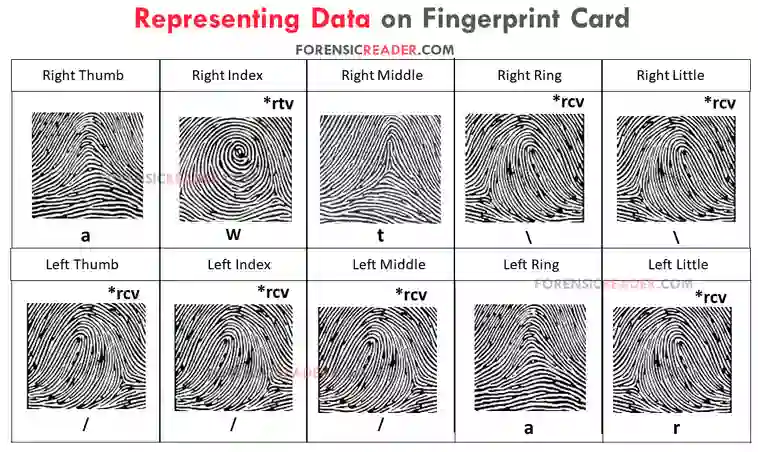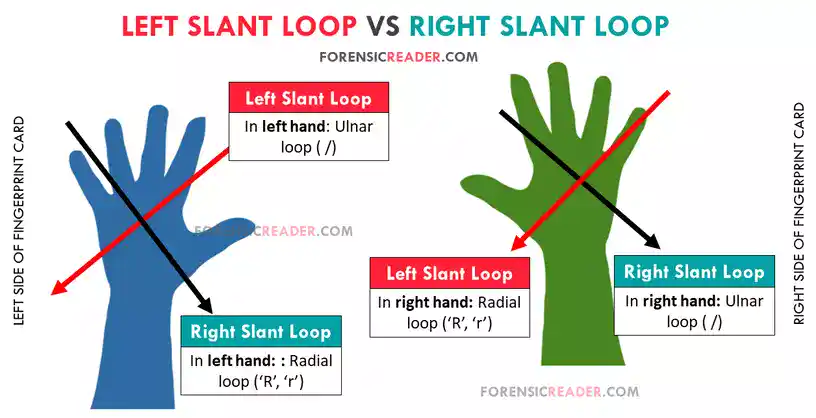One of the most important aspects of being a fingerprint examiner is determining Henry’s classification number.
To come up with Henry’s number, you first have to fill out and extract patterned information from a 10 digit card (also called blocking the fingerprint cad). The second step is to calculate the Henry fingerprint value, and the third step is to feed it into the system.
And in each of these three-step processes, there are specific rules that are needed to follow.
Specifically, in this article, you will learn about the rules for filling and comes up with corresponding patterns type values.
Registering Fingermarks in 10-Digit Fingerprint Card
Following are the best practices that you should follow while registering fingermarks.
A. Best Practice for Inking Fingers
- Fingers should be clean, dry, and dirt-free.
- The inking plate should be thoroughly cleaned.
- If fingers are too dry, apply a small amount of hand moisturizer.
- Allow your finger to dry at room temperature if it is too wet.
- If fingers are sweating excessively, clean them with rubbing alcohol or alcohol wipes and then dry them.
B. Best Practice for Registering Prints
- A thin coat of ink should be applied to fingers using a roller or ink plate.
- Avoid smudged fingermarks by avoiding extra ink deposition at the edges and center of the finger.
- Avoid gray color (or fade) prints because of less inked fingers.
C. Best Practice for Rolled Fingerprints
- Rolled and even inked fingerprints are taken.
- For better registration, fingers are rolled with the help of an assistant.
- Direction of Rolling:
- Thumbs are rolled outward to inward i.e. toward your body.
- Fingers should be rolled away from the body (inward to outward)
- At registering fingermark,
- First, a finger should be firmly grasped to avoid slipping,
- gentle pressure is applied while rolling the finger(remember directions) in their respective positions over the fingerprint card, and finally
- lift the finger immediately.
Read More: National Crime Information Center (NCIC) Fingerprint Classification
Rules for Writing Information on Fingerprint Card
After registering all fingers in the right way, the next step is to identify the print and symbolize them accordingly. The following image is an example of a filled 10-digit card.

Rule 1: Writing Pattern Type at Bottom
At the bottom of each rolled fingerprint, all pattern information should be written. However, other information such as ridge counts and ridge traces are written at the top right corner of each fingerprint box.
- Patterns type: middle bottom
- Ridge count/trace value: top right corner
Rule 2: Designation For Index Finger
For the index finger, capital letters values of the pattern type are used, except ulnar loops.
| S.No. | Patterns | Symbols |
|---|---|---|
| 1. | Plain Arch | A |
| 2. | Tented Arch | T |
| 3. | Radial Loop | R |
| 4. | Plain Whorl | W |
| 5. | Central Pocket Loop Whorl | C |
| 6. | Double Loop | D |
| 7. | Accidental Loop Whorls | X |
Rule 3: Designation of All Finger Other than Index
Unlike the index finger, all other fingers (including thumbs) pattern type is given by small letters.
There are two exceptions, one is the ulnar loop and the second is whorl.
| S.No. | Patterns | Symbols |
|---|---|---|
| 1. | Plain Arch | a |
| 2. | Tented Arch | t |
| 3. | Radial Loop | r |
Rule 4: Designation for Ulnar loops
Ulnar are registered as per the direction of their appearance in the 10-digit prints and called to right and left slant loops. They are also called diagonal line slanting patterns. [Read More: Loop Fingerprint Pattern: 5 Rules and 4 Types With Images]

A. Right Slant Loop: Loops whose opening is toward the right of the 10 digit card of the fingerprint.
- Right slant in right hand: Ulnar loop (backslash, \).
- Right slant in left hand: Radial loop (for index, R; other fingers, small ‘r’).
B. Left Slant Loop: Those loop patterns that open toward the left of the fingerprint card.
- Left slant in the right hand: Radial loop (for index, R; other fingers, small ‘r’).
- Left slant in left hand: Ulnar loop (forward slash, /).
| Hands | Slant Loop Type | Loop Type | Symbol |
|---|---|---|---|
| Right Hand | Right Slant | Ulnar loop | Backslash (\) |
| Right Hand | Left Slant | Radial loop | R (index), r (for all fingers) |
| Left Hand | Right Slant | Radial loop | R (index), r (for all fingers) |
| Left hand | Left Slant | Ulnar loop | Forward slash (/) |
Rule 5: Designation for Whorls
Irrespective of which finger whorls appease, it is always written by capital letter i.e. ‘W’.
So, if whorls in the index finger, it is symboled by capital ‘W’. Similarly, for whorls in little fingers, the symbol remains the same i.e. capital ‘W’.
The very next step after extracting information from a 10-digit fingerprint card is to classify the fingerprint. This can be done by Henry Fingerprint Classification (check our article).
Also Read:
- Primary Classification of Fingerprint: Rules, Procedure And Worksheet
- Secondary Classification of Fingerprints With Small Letter Grouping
- Major Classification of Fingerprint: Rules, Procedure And Worksheet
- Sub Secondary Classification of Fingerprints: Rules, Calculation, And Example
- Extensions of Henry Fingerprint System: WCDX & Special Loops

FR Author Group at ForensicReader is a team of Forensic experts and scholars having B.Sc, M.Sc, or Doctorate( Ph.D.) degrees in Forensic Science. We published on topics on fingerprints, questioned documents, forensic medicine, toxicology, physical evidence, and related case studies. Know More.
